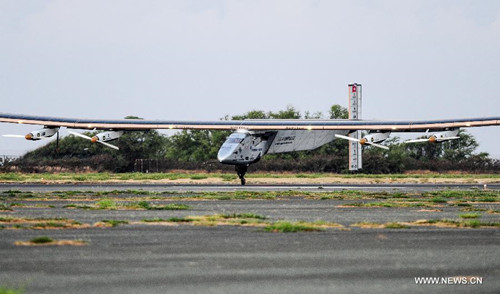
Solar Impulse 2 lands at Kalaeloa Airport in Honolulu, Hawaii, the United States, July 3, 2015. Solar Impulse 2 (SI2), the first solar-powered aircraft in an attempt to fly around the world, safely landed at Kalaeloa Airport in Honolulu, Hawaii, at 5:51 a.m. local time (1551 GMT), Friday after 118-hour non-stop flight over Pacific. (Photo: Xinhua/Zhang Chaoqun)
Solar Impulse 2 (SI2), the first solar-powered aircraft in an attempt to fly around the world, safely landed at Kalaeloa Airport in Honolulu, Hawaii, at 5:51 a.m. local time (1551 GMT), Friday after 118-hour non-stop flight over Pacific.
Swiss explorer Andre Borshberg, the pilot, finally walked out of the cockpit after remaining there waiting for one more hour upon landing.
The SI2 finished the 8,200 kilometer of non-stop solo flight from Nagoya of Japan before it landed successfully at the Kalaeloa Airport in Honolulu.
The craft reached the sky of Honolulu at 2 a.m. local time ( 1200 GMT), but due to the poor light condition of the airport at night, it had to hover in the sky for four more hours before landing at dawn.
Hawaii is the eighth leg of the plane's 35,000-kilometer journey around the world that started from Abu Dhabi, United Arab Emirates, on March 9. It is piloted alternatively by Swiss explorers Andre Borschberg and Bertrand Piccard.
On the trip from Japan to Hawaii, Borschberg navigated alone for 118 hours, almost 5 days and nights, in an unheated and unpressurised cockpit, sleeping in bursts of 20 minutes while on autopilot.
"Can you imagine that a solar-powered airplane without fuel can now fly longer than a jet plane," Piccard said earlier, "This is a clear message that clean technologies can achieve impossible goals. "
The solar plane weighs about as much as a family sedan and has 17,000 solar cells across its wingspan. It took 12 years to build this solar plane.
The round-the-world trip is expected to take some 25 flight days, broken up into 12 legs at speeds between 50 kph and 100 kph.
On the way to Hawaii, its average speed was around 70 kph.
SI2 initially left Nanjing, China, on May 31 for Hawaii, but was forced to land in the central Japanese city of Nagoya due to " a wall of clouds" over the Pacific.
The next leg of the flight will be from Honolulu to Phoenix, Arizona, and from there Borschberg and Piccard will fly together across the Atlantic on a return path to Abu Dhabi.
















































